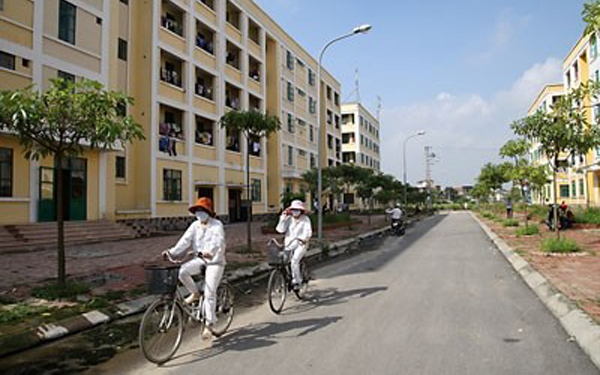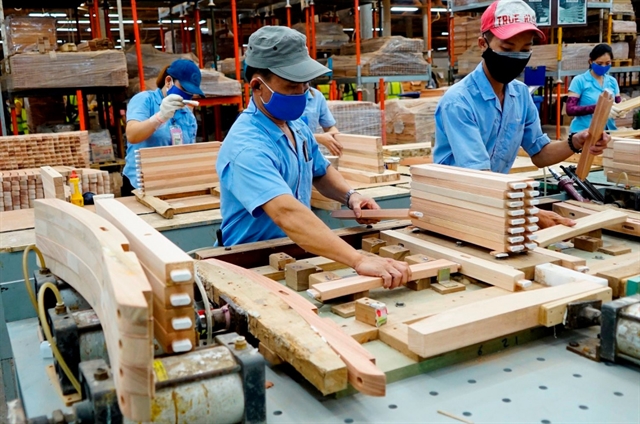 Society
Society


|
| Accommodation for low-income workers in industrial and economic zones (IZs and EZs) has become more scarce in the face of increasing demand.— Photo vov.vn |
HÀ NỘI – Accommodation for low-income workers in industrial and economic zones (IZs and EZs) has become more scarce in the face of increasing demand.
Many experts suggested that the Government needed to give priority to both procedures and capital to develop low-cost housing, said Kinh Tế & Đô Thị (Economy & City) Newspaper.
Nguyễn Hồng Cơ, from northern Hải Dương Province, said “I had to rent a house when my wife and I were working in Sài Đồng IZ in Hà Nội’s Long Biên District.”
“But as we struggled to find accommodation and schools for our child, my wife had to take the child and move back home to the countryside,” Cơ said.
“I quit the job in the IZ and became a xe ôm – motorbike taxi driver,” the man said.
This was due to the expensive rent for a small room which could not even fit my family, he said.
Cơ’s case was not rare.
It is becoming more common for workers to leave rural areas and search for work in the big cities.
According to statistics by the Ministry of Planning and Investment, Việt Nam will have 7.2 million employees working in IZs and EZs nationwide next year.
There will be 4.2 million workers needing accommodation, equal to 33.6 million sq.m of housing.
Currently, about 20 per cent of workers working in the IZs have found stable accommodation.
Most migrant workers had to rent small and shabby rooms.
On average, each worker had 2 or 3 sq.m of accommodation.
The makeshift and unhygienic accommodation was harmful to health and threatened security and social order in the IZs, said the paper.
With low income of VNĐ3-4 million (US$130-170) per month, they could not afford better places.
“I was unable to sleep during the summer, even at night,” Hường, a worker from Điềm Thuỵ IZ in Thái Nguyên Province told Thái Nguyên Newspaper.
“We could not afford air-conditioning,” she said.
To save money, the migrant workers often shared rooms with their colleagues.
“I share a room with two others to save money,” said Triệu Văn Tuấn, a worker in Sông Công IZ 1.
“The small room was really uncomfortable for three of us,” he said.
For married couples, they did not dare bring their children along.
Government support needed
The Government, in recent years, has spent money to carry out a national target programme on housing for low-income persons and workers in IZs and EZs.
Under the programme, next year there must be about 12 million sq.m of accommodation for workers nationwide.
But so far, only 4.1 million sq.m of housing, equal to 33 per cent of the target, has been completed.
According to Trần Huy Ánh, member of Hà Nội’s Architects’ Association, real estate businesses were not keen on housing projects for low-income buyers although the government had offered several preferential policies.
“Low profit and long capital return were major reasons hindering real estate enterprises,” Ánh said.
“This leads to a scarcity of accommodation for low-income people and especially poor migrant workers,” the architect said.
Recently, the Ministry of Finance has issued a circular offering preferential policies to housing projects for workers of IZs and EZs.
Accordingly, businesses who carry out the projects would receive income tax deductions based on expenses in construction, operation and lease of apartment buildings and infrastructure work for workers of IZs and EZs.
President of Việt Nam Real Estate Association Nguyễn Trần Nam said that in the past, the Government offered a credit package of VNĐ30 trillion (US$1.3 billion) for housing projects for low income people.
The credit package was useful to attract financial sources at the time, Nam said.
But after the credit package was terminated, smaller packages didn’t interest investors any more, Nam said.
Meanwhile, Nguyễn Mạnh Hà, president of the Việt Nam Real Estate Brokers’ Associations, said that housing development for low-income people was far below expectations.
This was due to a lack of land fund, Hà said.
“Although many IZs have been completed, there was no land for building accommodation for workers,” he said
Construction of for-lease accommodation needs long-term investment while bank interest rates were high.
That’s why the housing projects did not attract investors, he added.
The Government should consider a reasonable interest rates of 3 per cent per year to both investors and house buyers so as to attract financial sources, Nam suggested.
“Moreover, administrative procedures related to project evaluations, planning approval, and investment licensing should be further simplified,” he said. – VNS




